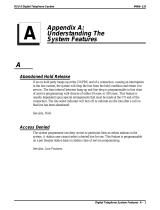
Explaining The Line Pooling Call Handling
Calls made through the pooled line feature are in the following sequence. (Should an internal error occur during
call routing, the system reports that error to the system error log.) :
•
callers take their stations off hook;
•
they dial the ARS access code;
•
they then hear an internal dial tone that prompts them to dial the number they want to call;
•
the local node applies any call restrictions that are determined by the local class of service parameters;
•
ARS routes the calls to a local or remote route determined by the particular number dialed.
The controlling software enables a local node to save the last number that its callers dial through the ARS so that
they can redial the last number they dialed into the line pooling environment. Also, users can store at an autodial
location an ARS preselect as well as a line group preselect enabled for ARS along with a desired number.
Pressing this autodial button, causes the system to route the stored number through the line pooling feature. When
the lines in a line group are all network channels, the installer may map a button on the system stations that
automatically selects a ARS-enabled line group when user’s press it.
Arranging For Line Pooling
•
Gather the network channels that connect a node to a hub together in one of the available line groups. The
system will not allow you to mix network channels and non-channel lines in the same line group.
•
Program the line groups that contain network channels into ARS route tables in the same manner as you
would program any normal line group into the ARS tables.
Using DID, DNIS, and ANI Features Through The Network
The DXP, DXP Plus, and FX Series systems provide the DID, DNIS, and ANI support as part of their basic
software package. A typical application is to service the hub location with analog DID lines or digital service
offering DNIS and ANI. An application such as this centralizes the service to the hub and allows the system to
transparently route callers to the appropriate node. With such an arrangement, all DID block programming is
confined to the hub system.
DID (Direct Inward Dialing) is an analog service that allows callers to dial directly to a system station without
going through the system’s attendant. DNIS (Dialed Number Identification Service) is a feature provided by T1
service. DNIS supplies to the system the number that the caller dialed. ANI (Automatic Number Identification) is
also a feature often provide by T1 service. ANI supplies to the system the number of the calling party. Do not
confuse ANI with any caller ID feature. Caller ID is specifically not supported by the networking software.
When the system detects analog DID information or digital DNIS information, it compares the received digits to
information programmed into an appropriate ‘DID block table that is assigned to the incoming line. If the
received digits match a local extension number, that local station will ring. If the received digits match a remote
extension, the system seizes a network channel to the appropriate node and sends the call to ring at the remote
station.
If the incoming call provides ANI information, that information gets processed at the local system if the call is to
a local station, or gets processed at the remote system if the call is to a remote station. The network software
supports the following ANI services: DID, DNIS, R2 MF, R2 DTMF, and ISDN-PRI; however, the network
software does not support the E&M service.
In the case of Feature Group D INFO digits delivered over a Feature Group D line, the network system processes
the INFO digits locally and does not deliver them to a remote extension when it routes a call there.
14 — Understanding System-To-System Networking Features
IMI89–280 Installing And Using System-To-System Networking























